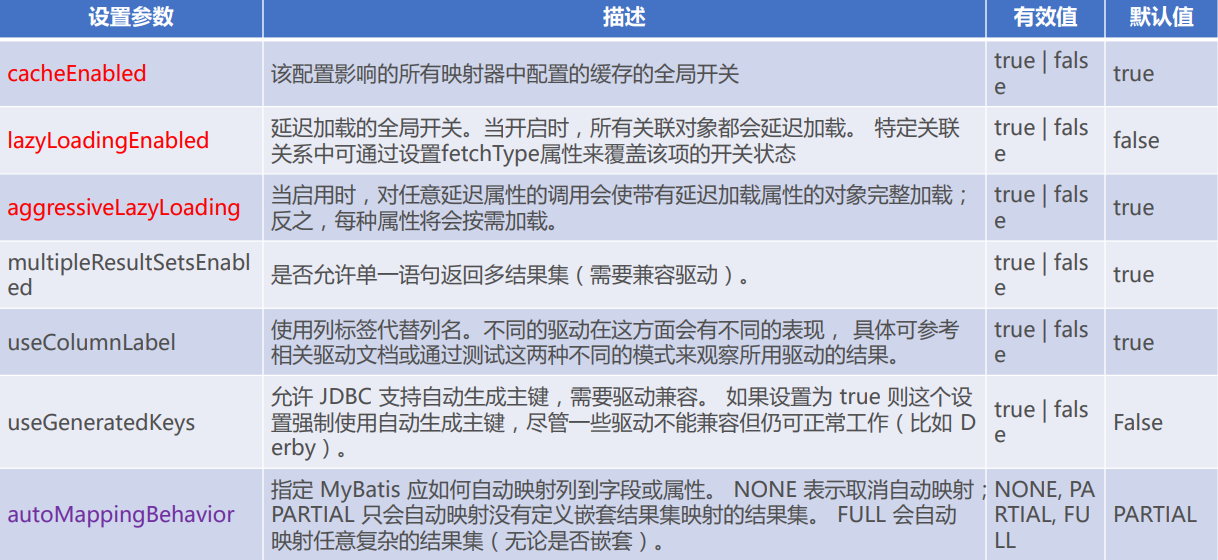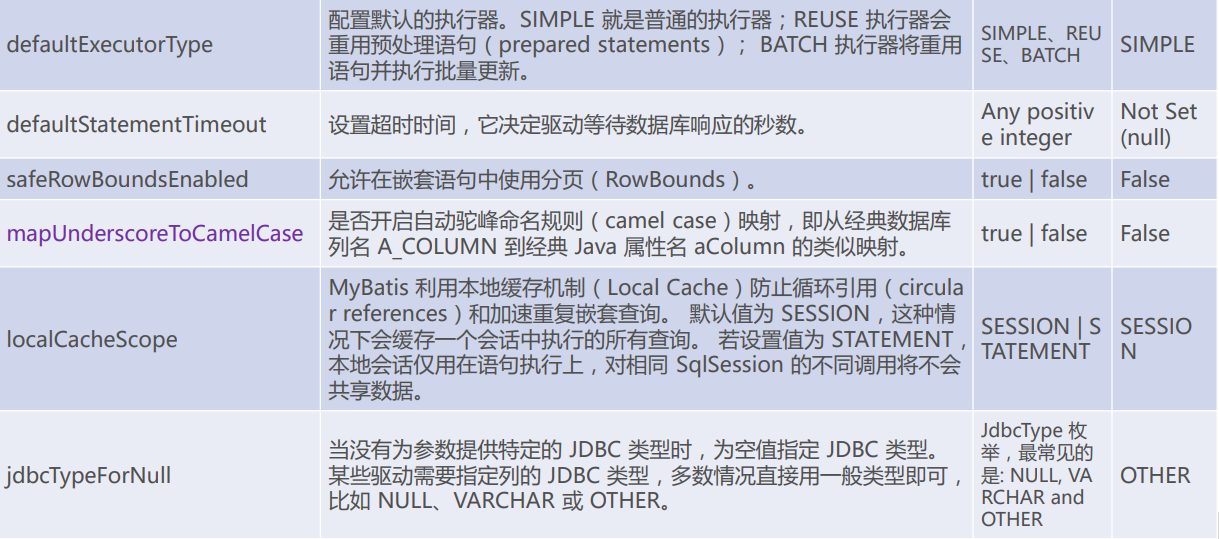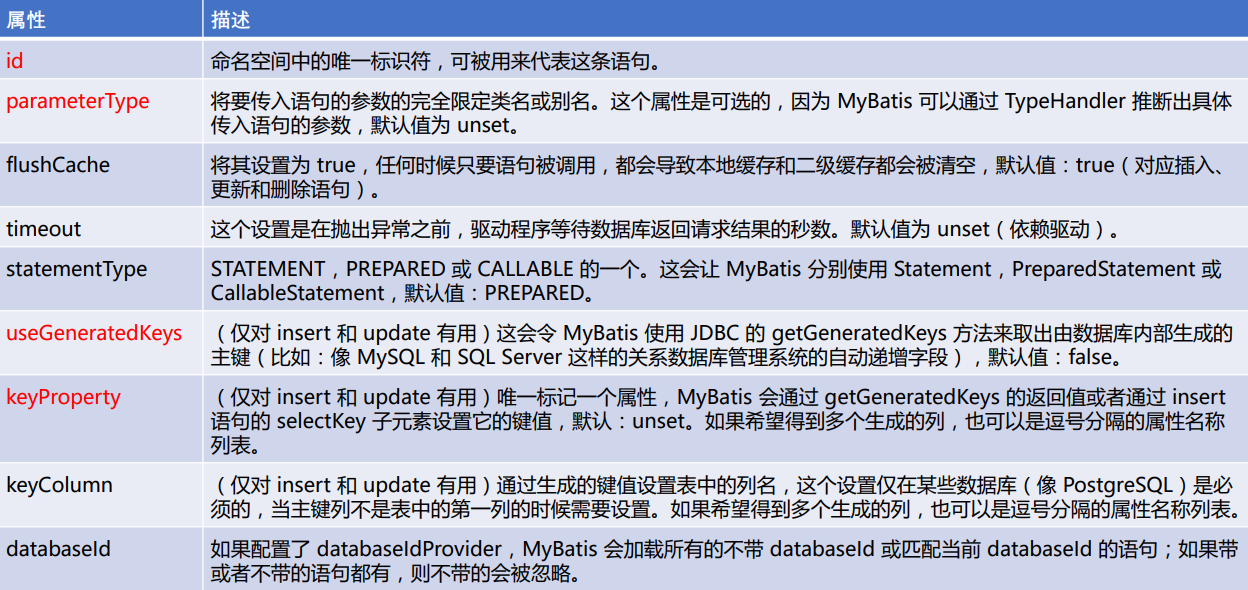Mybatis快速入门

1、SqlSessionFactoryBuilder:读取配置信 息创建SqlSessionFactory,建造者模式, 方法级别生命周期;
2、SqlSessionFactory:创建Sqlsession,工 厂单例模式,存在于程序的整个生命周 期;
3、SqlSession:代表一次数据库连接,可 以直接发送SQL执行,也可以通过调用 Mapper访问数据库;线程不安全,要保 证线程独享(方法级);
4、SQL Mapper:由一个Java接口和XML文 件组成,包含了要执行的SQL语句和结果 集映射规则。方法级别生命周期;
Mybatis配置

1、settings



<!-- 参数设置 --> <settings> <!-- 这个配置使全局的映射器启用或禁用缓存 --> <setting name="cacheEnabled" value="true" /> <!-- 全局启用或禁用延迟加载。当禁用时,所有关联对象都会即时加载 --> <setting name="lazyLoadingEnabled" value="true" /> <!-- 当启用时,有延迟加载属性的对象在被调用时将会完全加载任意属性。否则,每种属性将会按需要加载 --> <setting name="aggressiveLazyLoading" value="true" /> <!-- 允许或不允许多种结果集从一个单独的语句中返回(需要适合的驱动) --> <setting name="multipleResultSetsEnabled" value="true" /> <!-- 使用列标签代替列名。不同的驱动在这方便表现不同。参考驱动文档或充分测试两种方法来决定所使用的驱动 --> <setting name="useColumnLabel" value="true" /> <!-- 允许JDBC支持生成的键。需要适合的驱动。如果设置为true则这个设置强制生成的键被使用,尽管一些驱动拒绝兼容但仍然有效(比如Derby) --> <setting name="useGeneratedKeys" value="true" /> <!-- 指定MyBatis如何自动映射列到字段/属性。PARTIAL只会自动映射简单,没有嵌套的结果。FULL会自动映射任意复杂的结果(嵌套的或其他情况) --> <setting name="autoMappingBehavior" value="PARTIAL" /> <!--当检测出未知列(或未知属性)时,如何处理,默认情况下没有任何提示,这在测试的时候很不方便,不容易找到错误。 NONE : 不做任何处理 (默认值) WARNING : 警告日志形式的详细信息 FAILING : 映射失败,抛出异常和详细信息 --> <setting name="autoMappingUnknownColumnBehavior" value="WARNING" /> <!-- 配置默认的执行器。SIMPLE执行器没有什么特别之处。REUSE执行器重用预处理语句。BATCH执行器重用语句和批量更新 --> <setting name="defaultExecutorType" value="SIMPLE" /> <!-- 设置超时时间,它决定驱动等待一个数据库响应的时间 --> <setting name="defaultStatementTimeout" value="25000" /> <!--设置查询返回值数量,可以被查询数值覆盖 --> <setting name="defaultFetchSize" value="100" /> <!-- 允许在嵌套语句中使用分页 --> <setting name="safeRowBoundsEnabled" value="false" /> <!--是否开启自动驼峰命名规则(camel case)映射,即从经典数据库列名 A_COLUMN 到经典 Java 属性名 aColumn 的类似映射。 --> <setting name="mapUnderscoreToCamelCase" value="false" /> <!--MyBatis 利用本地缓存机制(Local Cache)防止循环引用(circular references)和加速重复嵌套查询。 默认值为 SESSION,这种情况下会缓存一个会话中执行的所有查询。 若设置值为 STATEMENT,本地会话仅用在语句执行上,对相同 SqlSession 的不同调用将不会共享数据。 --> <setting name="localCacheScope" value="SESSION" /> <!-- 当没有为参数提供特定的 JDBC 类型时,为空值指定 JDBC 类型。 某些驱动需要指定列的 JDBC 类型,多数情况直接用一般类型即可,比如 NULL、VARCHAR OTHER。 --> <setting name="jdbcTypeForNull" value="OTHER" /> <!-- 指定哪个对象的方法触发一次延迟加载。 --> <setting name="lazyLoadTriggerMethods" value="equals,clone,hashCode,toString" /> </settings>
2、environments
environment 元素是配置一个数据源的开始,属性id是它的唯一标识
transactionManager 元素配置数据库事务,其中type属性有三种配置方式
- jdbc,采用jdbc的方式管理事务;
- managed,采用容器的方式管理事务,在JNDI数据源中使用; 、
- 自定义,自定义数据库事务管理办法;
dataSource 元素配置数据源连接信息,type属性是连接数据库的方式配置,有四种配置方式
- UNPOOLED 非连接池方式连接
- POOLED 使用连接池连接
- JNDI 使用JNDI数据源
- 自定义数据源
<!--配置environment环境 --> <environments default="development"> <!-- 环境配置1,每个SqlSessionFactory对应一个环境 --> <environment id="development1"> <!-- 事务配置 type= JDBC、MANAGED 1.JDBC:这个配置直接简单使用了JDBC的提交和回滚设置。它依赖于从数据源得到的连接来管理事务范围。 2.MANAGED:这个配置几乎没做什么。它从来不提交或回滚一个连接。而它会让容器来管理事务的整个生命周期(比如Spring或JEE应用服务器的上下文)。 默认情况下它会关闭连接。然而一些容器并不希望这样,因此如果你需要从连接中停止它,将closeConnection属性设置为false --> <transactionManager type="JDBC" /> <!-- <transactionManager type="MANAGED"> <property name="closeConnection" value="false"/> </transactionManager> --> <!-- 数据源类型:type = UNPOOLED、POOLED、JNDI 1.UNPOOLED:这个数据源的实现是每次被请求时简单打开和关闭连接。它有一点慢,这是对简单应用程序的一个很好的选择,因为它不需要及时的可用连接。 不同的数据库对这个的表现也是不一样的,所以对某些数据库来说配置数据源并不重要,这个配置也是闲置的 2.POOLED:这是JDBC连接对象的数据源连接池的实现,用来避免创建新的连接实例时必要的初始连接和认证时间。 这是一种当前Web应用程序用来快速响应请求很流行的方法。 3.JNDI:这个数据源的实现是为了使用如Spring或应用服务器这类的容器,容器可以集中或在外部配置数据源,然后放置一个JNDI上下文的引用 --> <dataSource type="UNPOOLED"> <property name="driver" value="com.mysql.jdbc.Driver" /> <property name="url" value="jdbc:mysql://localhost:3306/xhm" /> <property name="username" value="root" /> <property name="password" value="root" /> <!-- 默认连接事务隔离级别 <property name="defaultTransactionIsolationLevel" value="" /> --> </dataSource> </environment> <!-- 环境配置2 --> <environment id="development2"> <transactionManager type="JDBC" /> <dataSource type="POOLED"> <property name="driver" value="com.mysql.jdbc.Driver" /> <property name="url" value="jdbc:mysql://localhost:3306/xhm" /> <property name="username" value="root" /> <property name="password" value="root" /> <!-- 在任意时间存在的活动(也就是正在使用)连接的数量 --> <property name="poolMaximumActiveConnections" value="10" /> <!-- 任意时间存在的空闲连接数 --> <property name="poolMaximumIdleConnections" value="5" /> <!-- 在被强制返回之前,池中连接被检查的时间 --> <property name="poolMaximumCheckoutTime" value="20000" /> <!-- 这是给连接池一个打印日志状态机会的低层次设置,还有重新尝试获得连接,这些情况下往往需要很长时间(为了避免连接池没有配置时静默失败) --> <property name="poolTimeToWait" value="20000" /> <!-- 发送到数据的侦测查询,用来验证连接是否正常工作,并且准备接受请求。 --> <property name="poolPingQuery" value="NO PING QUERY SET" /> <!-- 这是开启或禁用侦测查询。如果开启,你必须用一个合法的SQL语句(最好是很快速的)设置poolPingQuery属性 --> <property name="poolPingEnabled" value="false" /> <!-- 这是用来配置poolPingQuery多次时间被用一次。这可以被设置匹配标准的数据库连接超时时间,来避免不必要的侦测 --> <property name="poolPingConnectionsNotUsedFor" value="0" /> </dataSource> </environment> <!-- 环境配置3 --> <environment id="development3"> <transactionManager type="JDBC" /> <dataSource type="JNDI"> <property name="data_source" value="java:comp/env/jndi/mybatis" /> <property name="env.encoding" value="UTF8" /> <!-- <property name="initial_context" value=""/> <property name="env.encoding" value="UTF8"/> --> </dataSource> </environment> </environments>
3、mapper
PS:第一种方式用的推荐使用,类文件和mapper文件可以不需要 放在一个文件夹中,xml文件也不会和java文件混合在一起;
A、用classPath下资源引用-----将mapper.xml文件放在resource文件夹下是常规做法
<mappers> <!--直接映射到相应的mapper文件 --> <mapper resource="sqlmapper/TUserMapper.xml" /> </mappers>
B、用类注册方式引用-----将mapper.xml文件与Mapper接口放在同一路径下
<mappers> <!—通过类扫描mapper文件 --> <mapper class="com.enjoylearning.mybatis.mapper.TUserMapper" /> </mappers>
C、使用包名引入引射器名-----与B同理
<mappers> <!—扫描包下所有的mapper文件 --> <package name="com.enjoylearning.mybatis.mapper"/> </mappers>
D、用文件的全路径引用
<!-- 映射文件,mapper的配置文件 --> <mappers> <!--直接映射到相应的mapper文件 --> <mapper resource="com/xhm/mapper/UserMapper.xml" /> <!--扫描包路径下所有xxMapper.xml文件 --> <package name="com.xhm.mapper" /> </mappers>
基于xml配置的映射器
cache – 给定命名空间的缓存配置。
cache-ref – 其他命名空间缓存配置的引用。
resultMap – 是最复杂也是最强大的元素,用来描述如何从数据库结果集中来加载对象。
sql – 可被其他语句引用的可重用语句块。
insert – 映射插入语句
update – 映射更新语句
delete – 映射删除语句
select – 映射查询语句
select元素

自动映射
- 前提:SQL列名和JavaBean的属性是一致的;
- 自动映射等级autoMappingBehavior设置为PARTIAL,需要谨慎使用FULL;
- 使用resultType;
- 如果列名和JavaBean不一致,但列名符合单词下划线分割,Java是驼峰命名法, 则mapUnderscoreToCamelCase可设置为true;
传递多个查询入参
- 使用map传递参数;可读性差,导致可维护性和可扩展性差,杜绝使用;
- 使用注解传递参数;直观明了,当参数较少一般小于5个的时候,建议使用;
- 使用Java Bean的方式传递参数;当参数大于5个的时候,建议使用;
// 第一种方式使用map Map<String, Object> params = new HashMap<String, Object>(); params.put("email", email); params.put("sex", sex); List<TUser> list1 = mapper.selectByEmailAndSex1(params); System.out.println(list1.size()); // 第二种方式直接使用参数 List<TUser> list2 = mapper.selectByEmailAndSex2(email, sex); System.out.println(list2.size()); // 第三种方式用对象 EmailSexBean esb = new EmailSexBean(); esb.setEmail(email); esb.setSex(sex); List<TUser> list3 = mapper.selectByEmailAndSex3(esb); System.out.println(list3.size());
List<TUser> selectByEmailAndSex1(Map<String, Object> param); List<TUser> selectByEmailAndSex2(@Param("email")String email,@Param("sex")Byte sex); List<TUser> selectByEmailAndSex3(EmailSexBean esb);
resultMap元素
属性
resultMap 元素是 MyBatis 中最重要最强大的元素。它可以让你从 90% 的 JDBC ResultSets 数据提取代码中解放出 来,在对复杂语句进行联合映射的时候,它很可能可以代替数千行的同等功能的代码。
ResultMap 的设计思想是,简单的语句不需要明确的结果映射,而复杂一点的语句只需要描述它们的关系就行了。

resultMap元素 子元素
constructor - 用于在实例化类时,注入结果到构造方法中
- idArg - ID 参数;标记出作为 ID 的结果可以帮助提高整体性能
- arg - 将被注入到构造方法的一个普通结果
id – 一个 ID 结果;标记出作为 ID 的结果可以帮助提高整体性能
result – 注入到字段或 JavaBean 属性的普通结果
association – 一个复杂类型的关联;许多结果将包装成这种类型嵌套结果映射 – 关联可以指定为一个 resultMap 元素,或者引用一个
collection – 一个复杂类型的集合嵌套结果映射 – 集合可以指定为一个 resultMap 元素,或者引用一个
discriminator – 使用结果值来决定使用哪个 resultMap
- case – 基于某些值的结果映射嵌套结果映射 – 一个 case 也是一个映射它本身的结果,因此可以包含很多相 同 的元素,或者它可以参照一个外部的 resultMap
id & result
- id 和 result 都将一个列的值映射到一个简单数据类型(字符串,整型,双精度浮点数,日期等)的属性或字段
- 两者之间的唯一不同是, id 表示的结果将是对象的标识属性,这会在比较对象实例时用到。 这样可以 提高整体的性能,尤其是缓存和嵌套结果映射(也就是联合映射)的时候

constructor
- 一个pojo不存在没有参数的构造方法,就需要使用constructor;
- 为了通过名称来引用构造方法参数,你可以添加 @Param 注解,指定参数名称的前提下,以任意顺序编写 arg 元素
<constructor> <idArg column="id" javaType="int" /> <arg column="user_name" javaType="String" /> </constructor>
<resultMap id="BaseResultMap" type="TUser"> <!-- <constructor> <idArg column="id" javaType="int"/> <arg column="user_name" javaType="String"/> </constructor> --> <id column="id" property="id" jdbcType="INTEGER" /> <result column="user_name" property="userName" jdbcType="VARCHAR" /> <result column="real_name" property="realName" jdbcType="VARCHAR" /> <result column="sex" property="sex" jdbcType="TINYINT" /> <result column="mobile" property="mobile" jdbcType="VARCHAR" /> <result column="email" property="email" jdbcType="VARCHAR" /> <result column="note" property="note" jdbcType="VARCHAR" /> <result column="position_id" property="positionId" jdbcType="INTEGER" /> </resultMap>
insert, update 和 delete

<insert id="insert1" parameterType="TUser" useGeneratedKeys="true" keyProperty="id"> insert into t_user (id, user_name, real_name, sex, mobile, email, note, position_id) values (#{id,jdbcType=INTEGER}, #{userName,jdbcType=VARCHAR}, #{realName,jdbcType=VARCHAR}, #{sex,jdbcType=TINYINT}, #{mobile,jdbcType=VARCHAR}, #{email,jdbcType=VARCHAR}, #{note,jdbcType=VARCHAR}, #{positionId,jdbcType=INTEGER}) </insert>
selectKey元素

<selectKey keyProperty=“id” order= " Before" resultType="int"> select SEQ_ID.nextval from dual </selectKey>
sql元素和参数
sql元素:用来定义可重用的 SQL 代码段,可以包含在其他语句中;
参数:向sql语句中传递的可变参数
- 预编译 #{}:将传入的数据都当成一个字符串,会对自动传入的数据加一个双引号,能够很大程度防止 sql注入;
- 传值 ${}:传入的数据直接显示生成在sql中,无法防止sql注入;
- 表名、选取的列是动态的,order by和in操作, 可以考虑使用$
<select id="selectBySymbol" resultMap="BaseResultMap"> select #{inCol} from ${tableName} a where a.sex = #{sex} order by ${orderStr} </select>
动态sql元素

注解方式配置
注解方式就是将SQL语句直接写在接口上,对于需求比较简单的系统,效率较高。缺点在于,每次修改sql语句 都要编译代码,对于复杂的sql语句可编辑性和可读性都差,一般不建议使用这种配置方式;
@Select
@Results
@Insert
@Update
@Delete
@Results(id="jobInfo",value={ @Result(property="id",column="id",id = true), @Result(property="userId",column="user_id"), @Result(property="compName",column="comp_name"), @Result(property="years",column="years"), @Result(property="title",column="title") }) @Select("select id, user_id, comp_name, years, title from t_job_history" + " where user_id = #{userId}") List<TJobHistory> selectByUserId(int userId); @ResultMap("jobInfo") @Select("select id, user_id, comp_name, years, title from t_job_history") List<TJobHistory> selectAll(); @Insert("insert into t_job_history (id, user_id, comp_name, years, title)" + " values (#{id,jdbcType=INTEGER}, #{userId,jdbcType=INTEGER}," + "#{compName,jdbcType=VARCHAR}," + "#{years,jdbcType=INTEGER}, #{title,jdbcType=VARCHAR})") @Options(useGeneratedKeys=true,keyProperty="id") int insert(TJobHistory record);
批量操作
- 通过foreach动态拼装SQL语句
- 使用BATCH类型的excutor
例一:
<sql id="Base_Column_List"> id, user_name, real_name, sex, mobile, email, note, position_id </sql> <select id="selectIfandWhereOper" resultMap="BaseResultMap"> select <include refid="Base_Column_List" /> from t_user a <where> <if test="email != null and email != ''"> and a.email like CONCAT('%', #{email}, '%') </if> <if test="sex != null "> and a.sex = #{sex} </if> </where> </select>
例二:
<select id="selectForeach4In" resultMap="BaseResultMap"> select <include refid="Base_Column_List" /> from t_user a where a.user_name in <foreach collection="array" open="(" close=")" item="userName" index="i" separator=","> #{userName} </foreach> </select> <insert id="insertForeach4Batch"> insert into t_user (user_name, real_name, sex, mobile,email,note, position_id) values <foreach collection="list" separator="," item="user"> ( #{user.userName,jdbcType=VARCHAR}, #{user.realName,jdbcType=VARCHAR}, #{user.sex,jdbcType=TINYINT}, #{user.mobile,jdbcType=VARCHAR}, #{user.email,jdbcType=VARCHAR}, #{user.note,jdbcType=VARCHAR}, #{user.positionId,jdbcType=INTEGER} ) </foreach> </insert>
例三:
SqlSession sqlSession = sqlSessionFactory.openSession(ExecutorType.BATCH, false);
SqlSessionFactory sqlSessionFactory=getSqlSessionFactory(); //可以执行批量操作的sqlSession SqlSession openSession=sqlSessionFactory.openSession(ExecutorType.BATCH); //批量保存执行前时间 long start=System.currentTimeMillis(); try{ EmployeeMapper mapper= openSession.getMapper(EmployeeMapper.class); for (int i = 0; i < 1000; i++) { mapper.addEmp(new Employee(UUID.randomUUID().toString().substring(0,5),"b","1")); } openSession.commit(); long end= System.currentTimeMillis(); //批量保存执行后的时间 System.out.println("执行时长"+(end-start)); //批量 预编译sql一次==》设置参数==》10000次==》执行1次 677 //非批量 (预编译=设置参数=执行 )==》10000次 1121 }finally{ openSession.close(); }
mapper.xml
<mapper namespace="com.agesun.mybatis.dao.EmployeeMapper" <!--批量保存员工 --> <insert id="addEmp"> insert into employee(lastName,email,gender) values(#{lastName},#{email},#{gender}) </insert> </mapper>
补充:
在SSM框架中使用batch方式的批量插入
1、在全局配置文件applcationContext.xml中加入
<!-- 配置一个可以批量执行的sqlSession --> <bean id="sqlSession" class="org.mybatis.spring.SqlSessionTemplate"> <constructor-arg name="sqlSessionFactory" ref="sqlSessionFactory"></constructor-arg> <constructor-arg name="executorType" value="BATCH"></constructor-arg> </bean>
2、在serviceImpl中加入
@Autowired private SqlSession sqlSession; //批量保存员工 @Override public Integer batchEmp() { //批量保存执行前时间 long start=System.currentTimeMillis(); EmployeeMapper mapper= sqlSession.getMapper(EmployeeMapper.class); for (int i = 0; i < 10000; i++) { mapper.addEmp(new Employee(UUID.randomUUID().toString().substring(0,5),"b","1")); } long end= System.currentTimeMillis(); long time2= end-start; //批量保存执行后的时间 System.out.println("执行时长"+time2); return (int) time2; }
总结:性能对比
插入通常有三种方式,分别为for循环插入、batch插入、foreach插入,性能总结如下:
1.for循环insert
long start = System.currentTimeMillis(); for(int i = 0 ;i < 100000; i++) { User user = new User(); user.setId("id" + i); user.setName("name" + i); user.setPassword("password" + i); userMapper.insert(user); } long end = System.currentTimeMillis(); System.out.println("---------------" + (start - end) + "---------------");
<insert id="insert"> INSERT INTO t_user (id, name, password) VALUES(#{id}, #{name}, #{password}) </insert>
时间为380826ms
2、Mybatis batch模式
SqlSession sqlSession = sqlSessionTemplate.getSqlSessionFactory().openSession(ExecutorType.BATCH, false);//跟上述sql区别 UserMapper userMapper = sqlSession.getMapper(UserMapper.class); long start = System.currentTimeMillis(); for (int i = 0; i < 100000; i++) { User user = new User(); user.setId("id" + i); user.setName("name" + i); user.setPassword("password" + i); userMapper.insert(user); } sqlSession.commit(); long end = System.currentTimeMillis(); System.out.println("---------------" + (start - end) + "---------------");
<insert id="insert"> INSERT INTO t_user (id, name, password) VALUES(#{id}, #{name}, #{password}) </insert>
时间为203660ms
3、批量foreach插入
long start = System.currentTimeMillis(); List<User> userList = new ArrayList<>(); for (int i = 0; i < 100000; i++) { User user = new User(); user.setId("id" + i); user.setName("name" + i); user.setPassword("password" + i); userMapper.insert(user); } userMapper.insertBatch(userList); long end = System.currentTimeMillis(); System.out.println("---------------" + (start - end) + "---------------");
<insert id="insertBatch"> INSERT INTO t_user (id, name, password) VALUES <foreach collection ="userList" item="user" separator =","> (#{id}, #{name}, #{password}) </foreach > </insert>
时间为8706ms
结论:foreach批量插入 > mybatis batch模式插入 > for循环insert